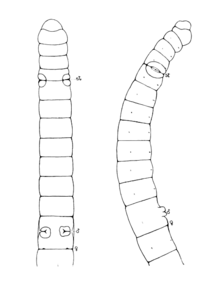User:Nguy2183/sandbox
This animal-related article may require cleanup to conform to a higher standard of quality. |
This article needs attention from an expert in Animal. Please add a reason or a talk parameter to this template to explain the issue with the article. (December 2009) |
| Mesenchytraeus solifugus | |
|---|---|

| |
| Scientific classification | |
| Kingdom: | |
| Phylum: | |
| Class: | |
| Subclass: | |
| Order: | |
| Family: | |
| Genus: | |
| Species: | M. solifugus
|
| Binomial name | |
| Mesenchytraeus solifugus (Emery, 1898)
| |

Mesenchytraeus solifugus is a species of Oligochaete worms commonly called ice worms.
Description[edit]
Adult ice worms measure around 15 mm in length and about 0.5 mm in diameter. Their fluid and flexible body squeezes through air holes and tiny crevasses in ice.
It is believed that the ice worm has a life span of five to ten years.
Ice worms have heavy pigment, absorbing all colours or reflecting dark brown. Yet strangely, they burrow into the glacier to avoid strong sunlight. Carlo Emery named the species solifugus in 1898, meaning "fleeing from the sun".
Distribution and habitat[edit]
Ice worms populate coastal glaciers in North America from Alaska to northern Washington State.
The worms appear on the surface in high density; researchers have counted between 30 and 300 ice worms per square metre. On Byron glacier alone, researchers estimate the worms numbered around 30 million. The total number in all the coastal glaciers easily surpasses the entire human population.
Ecology[edit]
Mesenchytraeus solifugus have a very narrow acceptable temperature range. Ice worms freeze at around −6.8 °C, and their bodies decompose after continuous exposure to temperatures above 5 °C. This decomposition process, known as autolysis, occurs when the cells produce digestive enzymes and self-destruct. The body literally melts.
They are the only known worm to spend their entire life in temperatures near 0 °C. Even if other places are equally cold, ice worms never venture onto any other terrain. They eat the abundant snow algae and pollen carried by the wind.
In the summer, ice worms follow a diurnal cycle—at the first light in the morning, they sink into the glacier. A few hours before sunset, they poke out from the snow.
Ice worms can still be found in broad daylight. Many of them gather in glacial ponds or small streams. Scientists believe the water blocks out the sun's longer wavelengths which the worms avoid, and the freezing water provides the worms with comfortable temperature.
In fast flowing glacial streams, an ice worm clings onto the icy surface. Researchers have observed the worms gyrate their head in the stream, possibly catching algae and pollens carried by the water. In still ponds, ice worms gather in bundles. Researchers speculate this has something to do with their reproduction. Ice worms do not graze in groups on the surface. The bonding in the still pond provides the rare opportunity for breeding.
Since in the winter the surface temperature on a glacier could reach −40 °C, scientists doubt the worms follow the diurnal pattern. The worms most likely remain below the surface. The snowfall provides insulation and the temperatures below maintain a stable 0 °C. Ice worms can still find plenty of algae in the firn layer, the layer of packed snow in transition to ice. Scientists know little about the ice worm during the winter as the inaccessibility of glaciers prevents further study.
Medical uses[edit]
Researchers are now investigating what prevents the worm from freezing at 0 °C. and looking for the evolutionary steps by which the ice worm diverged from other species.[citation needed] Understanding the ice worm’s secret could help preserve vital organs for transplant, and could aid in understanding of possible life forms on cold planets.[clarification needed]
Sources[edit]
- Hartzell, P. (2003). Glacial Ecology: North Cascades Glacier Macroinvertebrates. Retrieved on Oct. 21, 2005, from: http://www.nichols.edu/departments/glacier/bio/index.htm
- Pelto, M. S. (2003). Ice Worms (Mesenchytraeus solifugus) and Their Habitats on North Cascade Glaciers. A study by North Cascade Glacier Climate Project. Retrieved on Sept. 28, 2005, from http://www.nichols.edu/departments/glacier/iceworm.htm
- Shain, D. H., Carter M. R., Murray, K. P., Maleski, K. A., Smith, N. R., McBride, T. R., et al. (2000). Morphologic Characterization of the Ice Worm Mesenchytraeus solifugus. Journal of Morphology, 246, 192-197.
- Shain, D. H., Mason, T. A., Farrell, A. H., & Michalewicz, L. A. (2001). Distribution and behavior of ice worms (Mesenchytraeus solifugus) in south-central Alaska. Canadian Journal of Zoology, 79, 10, 1813-1821.

